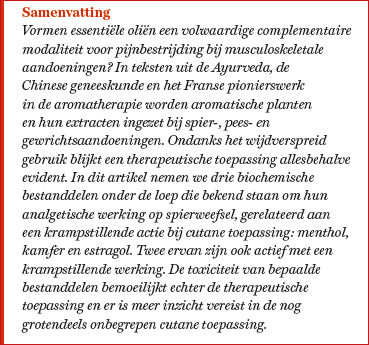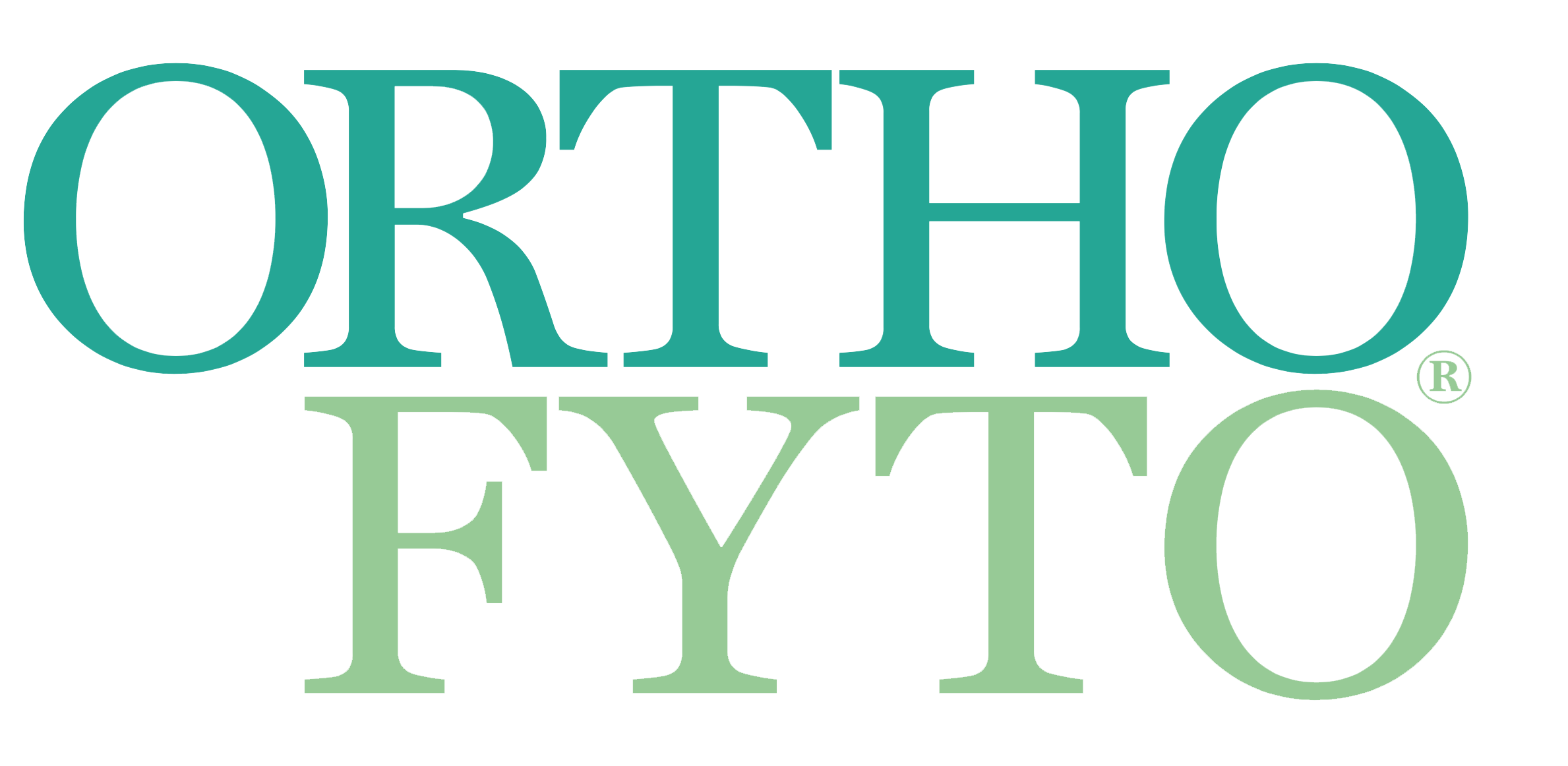Essentiële oliën bij musculoskeletale pijn
05 Oct, 2021
Door: Geert De Vuyst
 De pijnstillende activiteit van essentiële oliën bij de behandeling van musculoskeletale aandoeningen (MSA) berust vaak op een krampstillende werking op skeletspieren of op een ontstekingsremmende werking. In dit artikel zijn we primair geïnteresseerd in pijnstilling gerelateerd aan krampstilling. Als secundair doel kunnen bepaalde essentiële oliën ingezet worden als sedativum of anxiolyticum bij stress, vermoeidheid, depressie of slaapstoornissen ten gevolge van chronische pijn.1 Toepassingen van essentiële oliën bij neuropathische of radiculaire pijn, en pijn door infectieuze aandoeningen vallen buiten het bestek van deze beschouwing.
De pijnstillende activiteit van essentiële oliën bij de behandeling van musculoskeletale aandoeningen (MSA) berust vaak op een krampstillende werking op skeletspieren of op een ontstekingsremmende werking. In dit artikel zijn we primair geïnteresseerd in pijnstilling gerelateerd aan krampstilling. Als secundair doel kunnen bepaalde essentiële oliën ingezet worden als sedativum of anxiolyticum bij stress, vermoeidheid, depressie of slaapstoornissen ten gevolge van chronische pijn.1 Toepassingen van essentiële oliën bij neuropathische of radiculaire pijn, en pijn door infectieuze aandoeningen vallen buiten het bestek van deze beschouwing.
Onze interesse gaat uit naar types plantenextract zoals beschreven in ISO 9235:2021; als essentiële olie (EO) bekomen door stoomdistillatie of door koude persing en superkritisch CO2-extract.2 Deze toelichting is niet louter semantisch. Gingerolen en shogaolen zijn bestanddelen van gember (Zingiber officinale) die aan de rizoom de scherpe herkenbare smaak en het unieke aroma geven.3 Beide bestanddelen bieden een mogelijke verklaring voor de pijnstillende werking van gember bij ontstekingsaandoeningen.4 Gingerolen en shogaolen zijn echter niet-vluchtig, waardoor ze niet door het distillatieproces komen. Als we ze willen inzetten bij pijnbestrijding, als antagonist van receptor TRPV1, dienen we dus gebruik te maken van het CO2-extract, of de verse of gedroogde rizoom, dat beide bestanddelen bevat.5
Andere extractiemethoden sluiten we uit: zowel van droog extract, vers hydroalcoholisch extract alsook infuus. Dit betekent niet dat we een orale toedoening van essentiële oliën bij MSA diskwalificeren, al is klinisch onderzoek beperkt. Een Cochrane-review door Cameron en Chrubasik uit 2014 evalueert 47 RCT's bij 5980 deelnemers die kruidentherapieën via orale toediening inzetten bij artrose. De review bevat geen studies naar de werking van essentiële oliën.6
Drie jaar later analyseerde een Brits team 13 Cochrane-reviews – 206 studies, 30.700 deelnemers – over acute en chronische pijn bij volwassenen, met een schrale oogst inzake MSA.7 Kruidentherapie voor acute pijnen ontbreekt. Enkel de review door Oltean et al. naar het effect van kruidengeneesmiddelen bij lagerugpijn bespreekt één enkele essentiële olie.8 Er werd echte lavendel (Lavandula angustifolia), verdund tot 3% v/v in druivenpitolie, ingezet in combinatie met acupressuur tijdens acht sessies gedurende drie weken bij 61 personen met subacute of chronische niet-specifieke lagerugpijn. De onderzoekers rapporteren verlaagde subjectieve pijnintensiteit en verbeterde laterale wervelkolomflexie en looptijd vergeleken met deelnemers die gebruikelijke zorg kregen.9 Soorten van het lavandula-geslacht vinden echter voornamelijk hun plaats bij ons secundair doel, als sedativum of anxiolyticum, en wel via inhalatie en verstuiving.
www.geertdevuyst.be
aroma.news/nl
Lees het gehele artikel vanaf pagina 18 in OrthoFyto 5/21.
Wilt u het gehele artikel als PDF bestand ontvangen? Bestel het dan hier voor € 3,50.
Bronvermelding:
1. Luis Vitetta, Flavia Cicuttini, & Avni Sali (2008). Alternative therapies for musculoskeletal conditions. Best Practice & Research Clinical Rheumatology, 22(3), 499-522.
Voor het secundair doel, zie bijvoorbeeld:
Toktam Sadat Firoozeei, Awat Feizi, Hossein Rezaeizadeh, Arman Zargaran, Hamid Reza Roohafza, & Mehrdad Karimi (2021). The antidepressant effects of lavender (Lavandula angustifolia Mill.): A systematic review and meta analysis of randomized controlled clinical trials. Complementary Therapies in Medicine, 59, Article 102679.
Davide Donelli, Michele Antonelli, Caterina Bellinazzi, Gian Franco Gensini, & Fabio Firenzuoli (2019). Effects of lavender on anxiety: A systematic review and meta analysis. Phytomedicine, 65, Article 153099.
Pi-Chu Lin, Pi-Hsia Lee, Shu-Ju Tsen, Yen-Miao Lin, Su-Ru Chen, & Wen-Hsuan Hou (2019). Effects of aromatherapy on sleep quality: A systematic review and meta analysis. Complementary Therapies in Medicine, 45, 156–166.
Eva Heuberger, Tapanee Hongratanaworakit, Carina Böhm, Ruth Weber, & Gerhard Buchbauer (2001). Effects of Chiral Fragrances on Human Autonomic Nervous System Parameters and Self evaluation. Chemical Senses, 26(3), 281–292.
2. Stoomdistillatie (3.12); koude persing (3.5); superkritisch CO2 extract (3.28), in: International Organization for Standardization (ISO) (2021). ISO 9235:2021 Aromatic natural raw materials – Vocabulary. (ISO Standard No. 9235:2021).
3. Harvey A. Schwertner, & Deborah C. Rios (2007). High performance liquid chromatographic analysis of 6 gingerol, 8 gingerol, 10 gingerol, and 6 shogaol in ginger containing dietary supplements, spices, teas, and beverages. Journal of Chromatography B, 856(1-2).
Shivanand D. Jolad, R. Clark Lantz, Aniko M. Solyom, Guan Jie Chen, Robert B. Bates, & Barbara N. Timmermann (2004). Fresh organically grown ginger (Zingiber officinale): Composition and effects on LPS induced PGE2 production. Phytochemistry, 65(13), 1937–1954.
4. Dedov, V.N., Tran, V.H., Duke, C.C., Connor, M., Christie, M.J., Mandadi, S.& Roufogalis, B.D. (2002). Gingerols: a novel class of vanilloid receptor (VR1) agonists. British Journal of Pharmacology, 137, 793–798.
5. Kelly C. Zancan, Marcia O. M. Marques, Ademir J. Petenate & M. Angela A. Meireles (2002). Extraction of ginger (Zingiber officinale Roscoe) oleoresin with CO2 and co solvents: a study of the antioxidant action of the extracts. The Journal of Supercritical Fluids, 24(1), 57–76.
6. Cameron, M & Chrubasik, S. (2014). Oral herbal therapies for treating osteoarthritis. Cochrane Database of Systematic Reviews, (5), 1465–1858.
7. Derry, S., Wiffen, PJ., Kalso, EA., Bell, RF., Aldington, D., Phillips, T., Gaskell, H.& Moore, RA. (2017). Topical analgesics for acute and chronic pain in adults ‐ an overview of Cochrane Reviews. Cochrane Database of Systematic Reviews, (5).
8. Oltean H, Robbins C, van Tulder MW, Berman BM, Bombardier C. & Gagnier JJ (2014). Herbal medicine for low back pain. Cochrane Database of Systematic Reviews, (12), Article CD004504.
9. Y.B Yip, & S.H.M Tse (2004). The effectiveness of relaxation acupoint stimulation and acupressure with aromatic lavender essential oil for non specific low back pain in Hong Kong: a randomised controlled trial. Complementary Therapies in Medicine, 12(1), 28–37.
10. Daniel N. Cortright, James E. Krause & Daniel C. Broom (2007). TRP channels and pain. Biochimica et Biophysica Acta (BBA) - Molecular Basis of Disease, 1772(8), 978–988.
11. Liu, Boyi, Fan, Lu, Balakrishna, Shrilatha, Sui, Aiwei, Morris, John B. & Jordt, Sven-Eric (2013). TRPM8 is the principal mediator of menthol induced analgesia of acute and inflammatory pain. Pain, 154(10), 2169–2177.
Daniel H. Craighead, Nathaniel B. McCartney, James H. Tumlinson, & Lacy M. Alexander (2017). Mechanisms and time course of menthol induced cutaneous vasodilation. Microvascular Research, 110, 43–47.
12. Voor een berekening i.f.v. de hoeveelheid menthofuraan en pulegone, zie, pp. 484, 590, 623-626: Tisserand, R & Young, R. (2014). Essential Oil Safety. (2 ed.). Elsevier - Churchill Livingstone. ISBN 9780443062414
13. Marcello Trevisani & Raffaele Gatti (2013). TRPV1 Antagonists as Analgesic Agents. The Open Pain Journal, 6, 108–118.
14. Zie Dedov et al., 2002
15. Zie Trevisani et. al, 2013 en:
Lindsey J. Macpherson, Adrienne E. Dubin, Michael J. Evans, Felix Marr, Peter G. Schultz, Benjamin F. Cravatt & Ardem Patapoutian (2007). Noxious compounds activate TRPA1 ion channels through covalent modification of cysteines. Nature, 445, 541–545.
McNamara, F. N., Randall, A. & Gunthorpe, M. J. (2005). Effects of piperine, the pungent component of black pepper, at the human vanilloid receptor (TRPV1). British journal of pharmacology, 144(6), 781–790.
Gorgani, L., Mohammadi, M., Najafpour, G.D.& Nikzad, M. (2017). Piperine—The Bioactive Compound of Black Pepper: From Isolation to Medicinal Formulations. Comprehensive Reviews in Food Science and Food Safety, 16, 124–140.
16. Voor de berekeningswijze, zie Tisserand, R & Young, R. (2014), pp. 484, 512-516.
17. Hamidpour R., Hamidpour S, Hamidpour M & Shahlari M.(2013). Camphor (Cinnamomum camphora), a traditional remedy with the history of treating several diseases. International Journal of Case Reports and Images, 4(2), 89., Article 86.
18. Lotnummers Pranarom: resp. #OF21625, #OF29462; #OF17481.
EO van het Salvia officinalis geslacht bevatten mogelijks de hoogste concentratie kamfer maar zijn extracten die de nodige voorzorgen eisen, onder meer door de aanwezigheid van de ester sabinylacetaat en het terpeenketon thujon.
19. Kotaka T, Kimura, S, Kashiwayanagi M, & Iwamoto W. (2014). Camphor Induces Cold and Warm Sensations with Increases in Skin and Muscle Blood Flow in Human. Biological and Pharmaceutical Bulletin, 37(12), 1913–1918.
20. Zie onder meer:
Archana P. Raina, & R. C. Misra (2018). Chemo divergence in essential oil composition among germplasm collection of five Ocimum species from eastern coastal plains of India. Journal of Essential Oil Research, 47–55.
Abhay Kumar Pandey, Pooja Singh, & Nijendra Nath Tripathi (2014).
21. Ratajc, P. (2018). How Essential Oils Work: A Bird’s Eye Overview.
22. Prinsloo G, Nogemane N, & Renee Street (2018). The use of plants containing genotoxic carcinogens as foods and medicine. Food and Chemical Toxicology, 116 B, 27–39.
Zie ook: Tisserand, R & Young, R. (2014)
Lotnummers Pranarom: EB: #OF17479; Dragon EO: #OF22313.
23. European Medicines Agency (2019). Public statement on the use of herbal medicinal products containing estragole. (EMA/HMPC/137212/2005 Rev. 1).
24. Andres Jara-Oseguera, Sidney A. Simon & Tamara Rosenbaum (2008). TRPV1: On the Road to Pain Relief. Current Molecular Pharmacology, 1(3).
25. The International Fragrance Association (2020). IFRA Standards Library. 49th Amendment.
26. Voor de berekeningswijze, zie Tisserand, R & Young, R. (2014), pp. 202-203, 439, 484, 552-555.
